Want to accelerate your strength, speed and power gains while adding some variation in the weight room? For 2024, we have updated this Guide to the Top Isometric Exercises to incorporate into your strength training program.
Isometric exercises, also known as static strength training, are contractions of a particular muscle for an extended period of time. Simply put, an isometric exercise is one that involves muscle engagement without movement. Instead, you pick one position and hold it. For example, in a plank or wall sit, the muscles are working, but not actively changing lengths.
“Isometric exercises increase the target muscle’s time under tension, which is a key growth stimulus,”
- Trevor Thieme C.S.C.S., Openfit Senior Fitness and Nutrition Content Manager
Because isometric exercises are done in one position without movement, they'll improve strength in only one specific position. You'd have to do many isometric exercises through your limb's whole range of motion to improve muscle strength across the range.
In positions like these, the muscle fibers are activated but since there are equal forces against each other, there is no movement. (Compare this to picking up a 20-pound dumbbell to do biceps curls—the force of the weight pushing down is less than the force you are using to lift the weight up).
Isometric Exercise Guide Sections
- Research On The Benefits of Isometric Exercise - fast link
- Frequency of Isometric Traning - fast link
- Difference Between Isometric and Dynamic Exercises - fast link
- Beginner Isometric Training Tips - fast link
- Top 20 Isometric Exercises - fast link
- Download The Infographic - fast link
- VertiMax Isometric Exercise Examples - fast link
Research On The Benefits Of Isometric Exercises
Every athlete wants to be able to generate a lot of explosive force. Isometric exercises, when added to a functional strength training program, have been shown to help athletes produce more speed and power. Studies have shown that that a 7 second muscle contraction increases your strength by about 5 percent.
Isometric resistance training (IRT) provides a variety of health and fitness benefits, including:
- Strength Maintenance and Improvement: Mayo Research shows IRT helps improve and maintain strength for specific muscle positions without the need for movement. This makes it particularly useful for enhancing stabilization and muscle engagement in targeted areas.
- Injury Recovery and Prevention: The research also shows It is beneficial for individuals recovering from injuries or dealing with conditions like arthritis, as it allows for muscle strengthening without putting undue strain on joints. This can lead to reduced pain and improved physical function.
- Blood Pressure Management: IRT research has been shown to effectively lower and control blood pressure, with benefits that are comparable to those of taking antihypertensive medication. This makes it a potentially valuable component of treatment plans for individuals with hypertension. *
- Safe for Everyone: The safety and efficacy of IRT, especially in terms of cardiovascular responses, has been validated in that same research. The acute increase in blood pressure during IRT is comparable to or lower than that observed with aerobic exercise, making it a safe option for individuals with varying levels of blood pressure.
- Keeps Your Blood Vessels Healthy: The training is linked to enhancements in endothelial function, which is crucial for maintaining vascular health and preventing cardiovascular diseases.
- Improves Blood Flow: IRT can induce structural adaptations in the vasculature, contributing to improved blood flow and reduced risk of vascular-related health issues.
- Fights Off Cell Damage: Engaging in IRT reduces oxidative stress, which is basically when your cells are under attack by toxins. This can keep your cells healthy and fend off chronic diseases, by improving the body’s antioxidant defense system.,
- Better Heart Rate Control: It can also help your heart and nervous system communicate better, leading to a more steady and healthy heart rate. By modulating the activity of the autonomic nervous system, it contributes to better heart rate variability and overall cardiovascular health.
* Check with your health care provider before beginning isometric exercises if you have high blood pressure or any heart problems.
*. Avoid holding your breath and straining during any weight training exercise as this may increase blood pressure.
Frequency: How Often Should You Do Isometric Exercises?
Isometric workouts can be a versatile part of your overall fitness routine. For beginners, starting with isometric exercises about 2-3 times a week can allow your muscles to adapt without overstraining them. As your endurance improves, you can integrate isometric holds into your daily workouts, especially as warm-ups or cool-downs. Importantly, listen to your body and provide adequate rest for any muscle groups worked extensively. Consistency and progression are key, with rest days critical for muscle recovery and growth.
Key Differences Of Isometric vs Dynamic Exercises
Isometric and dynamic exercises are two sides of the strength training spectrum, each with unique benefits. Learn more about Static Stretching vs Dynamic Stretching.
- Isometric Exercises involve holding a static position under tension. Here, the muscle length and joint angle do not change during contraction. Examples include planks and wall sits. The focus is on maintaining strength, improving stabilization, and enhancing muscle endurance without movement.
- Dynamic Exercises, on the other hand, involve movement through a range of motion. These exercises, such as squats, push-ups, and running, engage muscles through lengthening and shortening phases, known as eccentric and concentric contractions, respectively. Dynamic exercises are pivotal for improving muscle strength, power, and flexibility, and they better mimic everyday movements and athletic performance.
Choosing between the two often depends on your fitness goals, with a balanced approach often being the most beneficial.
Isometric Exercise Tips for Beginners
- Start Slowly: Begin with basic poses, like the plank or wall sit, focusing on form over duration. As you build strength, gradually increase the time you hold each position.
- Breathe Properly: Unlike dynamic exercises, isometric exercises can tempt you to hold your breath. Focus on breathing evenly throughout the hold to prevent spikes in blood pressure.
- Incorporate Variety: While isometric exercises strengthen muscles at a specific angle, varying your routine can help engage more muscle fibers and improve overall strength. Try different positions and exercises to target various muscle groups.
- Integrate Into Daily Life: Isometric exercises can easily be integrated into daily life. Practice holding your body in a squat position while brushing your teeth or do calf raises while standing in line.
- Listen to Your Body: Isometric exercises are generally safe, but they can be intense. If you feel sharp pain or discomfort, release the position. It’s crucial to distinguish between the sensation of muscle fatigue and pain that signals harm.
- Consult a Professional: If you’re unsure about how to start or if you have existing health concerns, consulting with a fitness professional can provide personalized advice and ensure you’re performing exercises correctly.
Incorporating isometric exercises into your fitness routine can provide unique benefits and add variety to your workouts. With proper technique, frequency, and progression, beginners can safely explore the advantages of isometric training.
Top 20 Isometric Exercises
The following exercises will ensure your entire body is being challenged to get stronger and reveal any areas of weakness. They’re simple to try, you can do them anywhere and they’ll give you a solid start toward gaining new levels of strength.
1. Plank

- Get on all fours with your feet together, arms straight, body straight from head to heels, and your hands in line with (but slightly wider than) your shoulders.
- Clench your glutes, draw your shoulders down, and brace your core to lock your body into position.
- Hold until fatigued. (Can also be performed on forearms like the above image.)
2. Low Squat
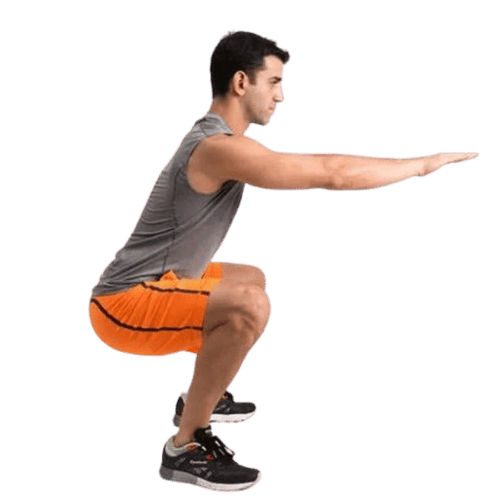
- Stand tall with your feet hip- to shoulder-width apart and your hands by your sides, toes pointed forward.
- Keeping your back flat and core braced, push your hips back, bend your knees, extend your arms forward, and lower your body as far as possible.
- Hold for time.
3. Split Squat
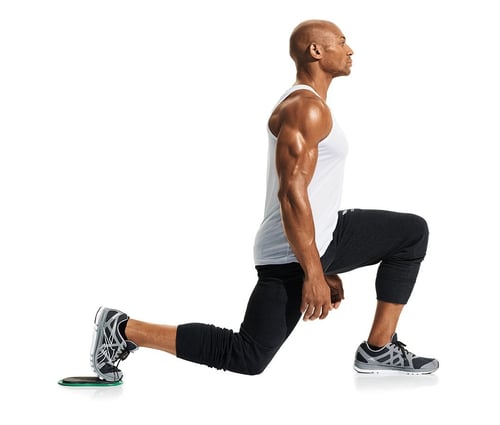
- If you have weak glutes and quads, then you are running a high risk of runner knee and a plethora of other overuse injuries - Split squats will help off set that risk.
- Take an athletic stance with back straight and core engaged, then step into a lunge position.
- Make the pose more challenging by sinking down until your front knee is bent to a 90 degrees and your back knee nearly touches the floor.
4. Wall Sit

- Stand with your back against a wall, your feet hip-width apart and your hands by your sides.
- Slide down the wall until your hips and knees are 90 degrees, with your shoulders and butt touching the wall.
- Hold until fatigued.
5. Calf Raise Hold
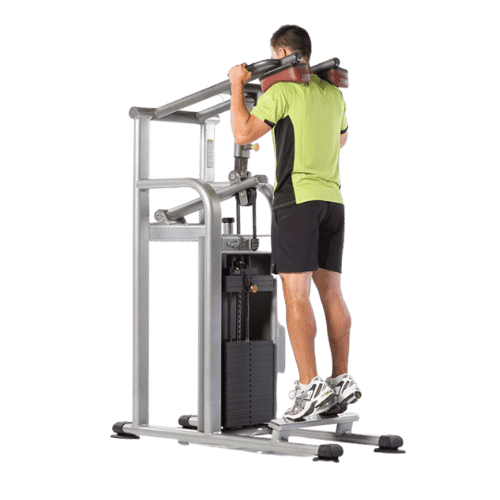
- Start by using with both legs, raise your heels and lift your body off the ground.
- Once you get as high as you can go, hold this position for 1 minute, then slowly come back down.
- As your body gets comfortable with this new stress, you can add another 30 seconds at a time you until you reach 5 minutes.
6. Leg Extensions
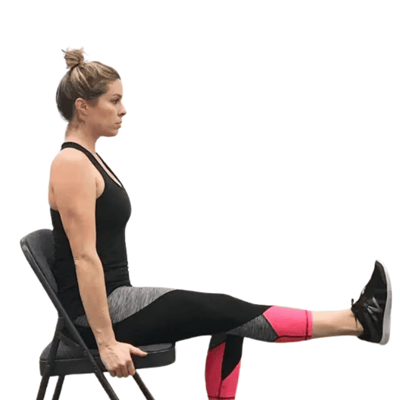
- Sit on a chair with your tailbone firmly against the back of the chair, hands resting on the chair with both feet flat on the floor.
- Slowly extend your right leg out in front of you, engage your quads, and reach your toes as much as you can without losing form.
- Hold the position for 30 seconds to one minute, then lower down to starting position and change sides.
7. Isometric Push-up
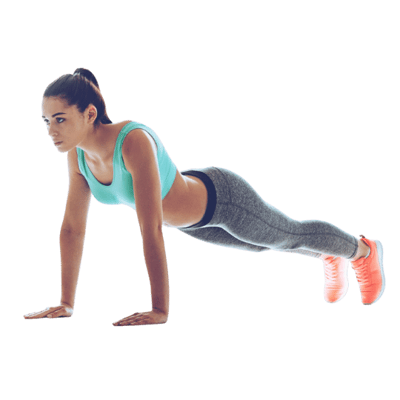
- Get on all fours with your feet together, your body straight from head to heels, and your hands in line with (but slightly wider than) your shoulders.
- Bend your elbows so that your upper arms flare out diagonally from your torso (you should form an arrow when viewed from above).
- Lower your body until your elbows form 90-degree angles, and hold until fatigued.
8. Static Lunge
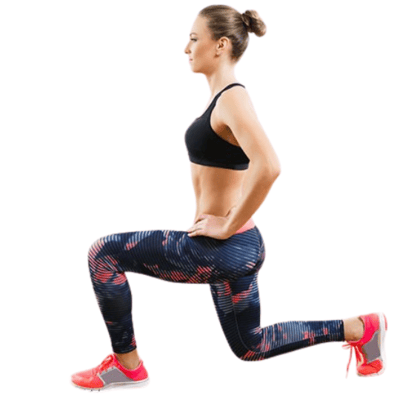
- Stand tall with your feet hip-width apart and your hands at your sides.
- Keeping your chest up, shoulders back, back flat, and core engaged, take a large step forward with your right foot. Lower your body until your front thigh is parallel with the ground and your left knee is bent 90 degrees.
- Hold until fatigued, performing equal reps on both sides.
9. Dumbbell Curl
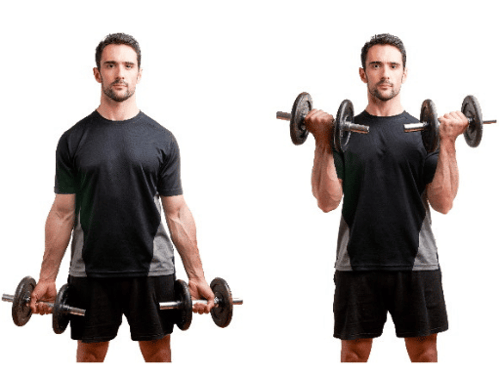
- Stand holding a pair of dumbbells at arm’s length by your sides, palms facing forward.
- Keeping your elbows tucked and your upper arms locked in place, curl the dumbbells until your forearms are parallel to the floor.
- Hold until fatigued.
10. Bench Press
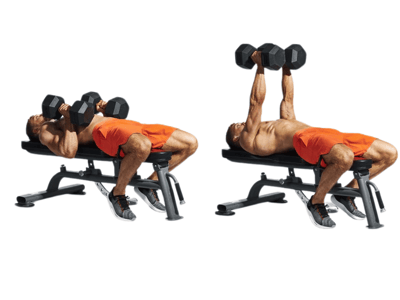
- Lie on a flat bench holding a pair of dumbbells or barbell directly above your chest with your palms facing forward. Your head, upper back, and butt should touch the bench, and your feet should be flat on the floor.
- Slowly lower to the sides of your chest, keeping your elbows close to your body.
- Stop when the weights are a few inches above your chest, and hold until fatigued.
11. Dead Hang

- Grab a pull-up bar with an over or underhand grip, your hands shoulder-width apart.
- Allow your body to hang with your legs crossed behind you or toes pointed toward the floor.
- Hold until fatigued.
12. Pull-Up Hold 
- Grasp pull-up bar with hands shoulder-width apart.
- Pull yourself up until your upper chest is even with the bar.
- With elbow down, focus on squeezing the shoulder blades together and hold the position for 1–2 minutes.
13. Scapular Retraction
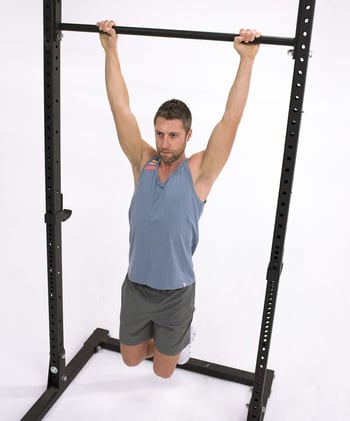
- Grab a pull-up bar with an overhand grip, your hands shoulder-width apart, and let your body hang.
- Draw your shoulders down and back to raise your shoulders just slightly toward the bar.
- Hold until fatigued.
14. Flexed-Arm Hang
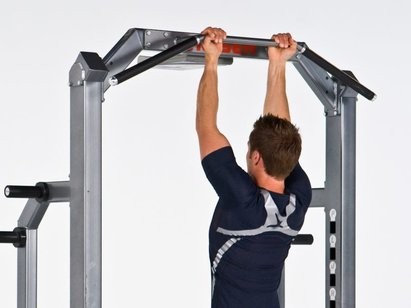
- Grab a pull-up bar with an underhand grip, your hands shoulder-width apart, and let your body hang.
- Pinch your shoulder blades down, then bend your elbows until your upper arms are parallel to the floor.
- Hold until fatigued.
15. Hollow-Body Hold
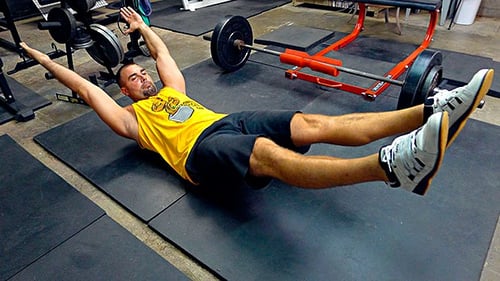
- Lie supine with the arms and legs in the air and the knees bent. Flatten out the lumbar spine so there's no gap between the floor and the low back.
- Pinch your shoulder blades down, and position your feet just in front of your body, with your legs straight. Engage your core. Your body should form a gentle C shape.
- Hold until fatigued.
16. Good Mornings
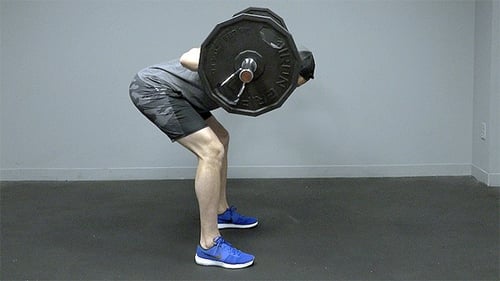
- Place an barbell on your back as if preparing to back squat. Hinge at the hips, and lower your chest until it’s parallel to the floor.
- Hold for 10 seconds, then return to standing.
- Next, hinge again, lowering torso to just 45 degrees. Hold 10 seconds, then return to standing.
17. Goblet Squat
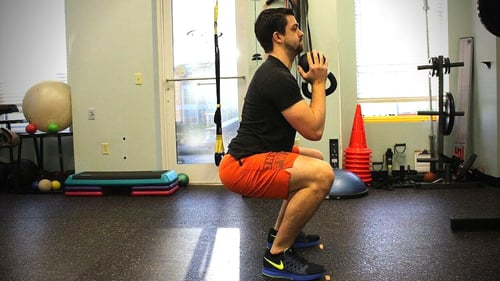
- Holding a heavy dumbbell or kettlebell in the front racked position with both hands in front of your chest, elbows tight to your sides, lower into a squat.
- Hold at the bottom of your range of motion (ideally parallel or just below) for 5 seconds, then press through heels and return to standing.
18. Lateral Shoulder Raise
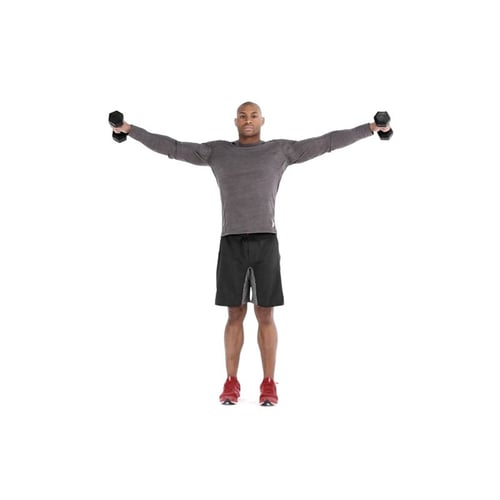
- Stand with your feet shoulder-width apart, with your knees slightly bent.
- Hold the weights at your sides with your arms straight but elbows unlocked.
- Raise the weights equally out to either side until they are shoulder height.
19. Upright Row

- Stand upright with your feet hip-distance apart and your knees slightly bent.
- Hold the barbell lightly in front of you with your arms straight.
- Bend your elbows to raise the weight up to shoulder level.
20. Bridge

- Lie down on your back on the floor. Flex your knees, keep your hands on the sides, and feet and palms flat on the ground.
- Support your body on your feet on and palms and gently thrust your hip upwards.
- Hold this position for 10 seconds before lowering your body back to the starting position.
Build Strength That Translates to Real Performance
Take your isometric training to the next level with VertiMax Training Systems—designed to improve power, balance, and control in every movement.
Top Isometric Exercises Using VertiMax Equipment
Utilizing VertiMax equipment to perform isometric exercises can enhance your static strength training program. Here are a few exercises that would likely benefit from the application of VertiMax's resistance technology.
- VertiMax Plank Hold: Using the VertiMax resistance bands attached to the waist, perform a plank. The added resistance increases core engagement.
- Isometric Squat: Stand on the VertiMax platform with the resistance bands attached to your waist. Lower into a squat position and hold. The resistance adds intensity, strengthening the quads, glutes, and core.
- Static Lunges: With one foot on the VertiMax platform and resistance bands attached at the waist level, step back into a lunge position and hold. This can intensify the work on the glutes and hamstrings.
- Wall Sit with VertiMax Resistance: While performing a traditional wall sit, use the VertiMax resistance bands attached to the waist to add extra pressure, increasing the challenge to your lower body.
- Isometric Shoulder Hold: Using the VertiMax hand straps, extend your arms in front of you or to the side and hold them static against the resistance. This exercise can target the deltoids and improve shoulder stability.
- Bicep Curl Hold: Stand on the VertiMax platform with the resistance bands attached to your hands. Curl your arms up to a 90-degree angle and hold against the resistance, focusing on the biceps.
- Tricep Extension Hold: Similar to the bicep curl hold but with your arms behind your head. Extend your arms up against the resistance and hold, targeting the triceps.
- Calf Raise Hold: Stand on the VertiMax platform, lift onto your toes against the resistance, and hold, strengthening the calf muscles.
The Takeaway...
These exercises are amazing examples of how you can get the most out of isometric exercise. But it’s important to note that a lot of other workouts can easily become isometric! During an exercise, if you hold your position during its peak contraction, you’re good to go.
With so many different ways to exercise, it can be hard to choose which path is right for you. Isometric exercises just may be the perfect addition to your workout routine if you:
- Have a shoulder injury
- Are looking for a different kind of fitness approach
- Are recovering from a knee surgery
- Experience chronic knee pain
- Are seeking a low-impact exercise






.png?width=110&name=Listing%20Image-basketball%20ladder%20drill%20%20(350%20x%20350%20px).png)














